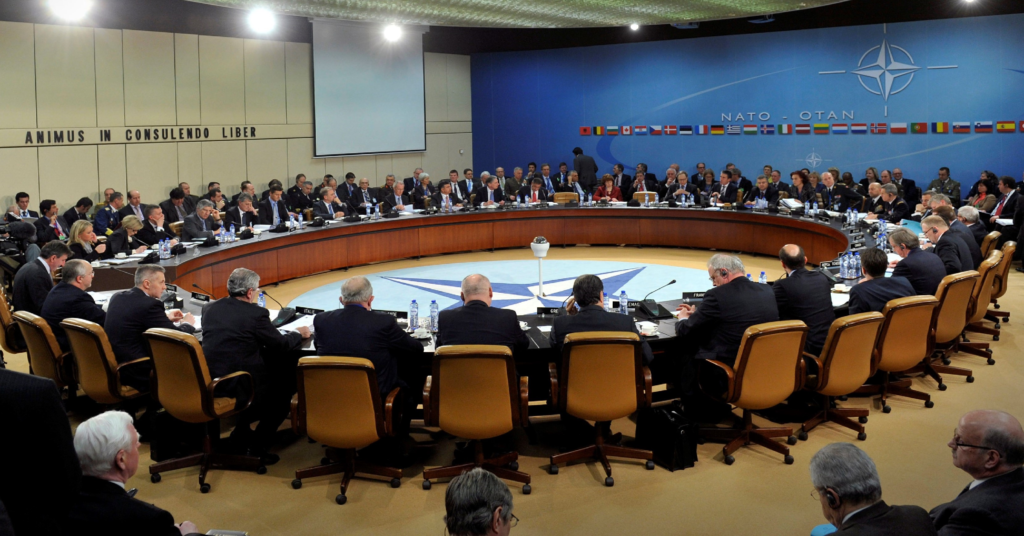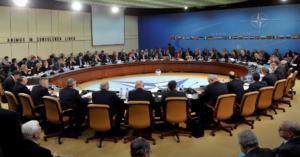

The Partnership also prompted Foreign Affairs to publish an article strongly in favor of rapid NATO expansion. Its authors, Ronald D. Asmus, Richard L. Kugler, and F. Stephen Larabee, argued that German-Russian nationalist competition was bound to recur unless the former Soviet satellites were incorporated into NATO and the EU. The “new NATO,” the authors concluded, must go “out of area or it will go out of business.”
This is from Walter A. McDougall, “NATO at Three Score and Ten: An Anticipatory
Elegy,” Law & Liberty, April 1, 2019. The piece is excellent.
It’s three things in one: (1) a nice history of NATO in its various phases, (2) a case against NATO, and (3) implicitly a public choice analysis of a sprawling bureaucracy.
Notice this paragraph:
But the founders took care to do nothing that Stalin might perceive as threatening. Thus Iceland remained disarmed and only agreed to host U.S. bases after heated debate. Denmark and Norway, which shared a small Arctic frontier with the USSR, joined NATO only on condition that they not host foreign bases in peacetime. Sweden, trusting instead in armed neutrality, did not join at all. Fifty years later, the allies displayed no such prudence.
Of course, now NATO has expanded right up to the border of Russia. What could go wrong?
At a Hoover event a few years ago celebrating the life of Robert Conquest, one of the speakers was my Hoover colleague and former U.S. ambassador to Russia, Michael McFaul. I asked him if he thought it was a mistake to expand NATO up to Russia’s borders. He said no, why would I think that? Because, I answered, the Russians, with their history of having lost 1/7 of their population in World War II, would feel threatened. He said there was no good reason for their being threatened. I asked him, “What if the Canadians pulled out of NATO and made an alliance with Russia, and then had Russian troops stationed in Canada? Wouldn’t you feel threatened?” “No,” he said.

READER COMMENTS
Kurt Schuler
Apr 2 2019 at 6:40pm
You may not remember this from your history class, but it wasn’t just the Germans who started World War II, it was also the Soviets. The Soviets launched an unprovoked invasion of eastern Poland two and a half weeks after the German invasion of western Poland began. The Soviets then went on to occupy the Baltic states in 1940, again in an unprovoked invasion. After World War II they occupied Estonia, Latvia, Lithuania, Poland, East Germany, Czechoslovakia, Hungary, Romania, and Bulgaria for decades. Poland has been occupied by Russia / the Soviet Union for three periods (1795-1918, 1939-1941 in eastern Poland, and 1944-1989). So, those countries have experience that gives them excellent reason to want protection against the possibility of Russian aggresssion.
On the other hand, what does Russia have to fear from them? The Estonians have never occupied Moscow, or even St. Petersburg. Ditto for the other countries listed above. Moreover, the NATO countries are democracies that have no interest in invading Russia, while Russia is a dictatorship that has invaded or supported separatist movements in Georgia and Ukraine.
Accordingly, for Russians to claim to be threatened by NATO is not just a mistake, it is an inversion of the truth. Westerners who give the claim credence are like those dupes of the Soviet era who thought they were promoting peace but were actually promoting tyranny.
David Henderson
Apr 3 2019 at 1:12pm
Thanks for your thoughtful comments, Kurt.
No, I don’t remember it from my history class; I was taught in a government school. But I do remember it and know it well.
I certainly agree with your point that the Soviet government was vicious and targeted innocent people in countries that had not attacked them.
I’m making a different point, though, a point that doesn’t contradict the above. My point is that Russians feel besieged when NATO comes right up to their border. Do you think that’s false? Do you think, in other words, that that doesn’t threaten them at all?
Kurt Schuler
Apr 4 2019 at 10:28pm
Thank you for the reply, David.
Six NATO countries border Russia. In the Bering Strait, Alaska’s Little Diomede Island is a couple of miles away from Siberia’s uninhabited Big Diomede Island. Beyond that on either side is a lot of cold water, ice, and tundra. The nearest substantial population centers are hundreds of miles away.
In Europe, Norway (population 5 million) has a short border with Russia (population 143 million) in the far north. Russia borders Norway because the Soviet Union took land formerly belonging to Finland, after invading in an act of unprovoked aggression in the Winter War of 1939-1940. Poland (population 38 million) and Lithuania (3 million) border the Russian exclave of Kaliningrad, which was previously part of Germany and taken by the Soviet Union during World War II. Estonia (population 1 million) and Latvia (2 million) are fairly close to St. Petersburg (population 5 million).
In summary, the U.S. maritime border with Russia is in the remotest and least populated part of both countries, while the European NATO countries bordering Russia are all much smaller than Russia, with correspondingly much smaller militaries. So yes, I think that NATO does not threaten Russia militarily at all, provided that Russia refrains from further aggression. To claim to be worried about Estonian aggression cannot be realistic; it is playacting.
David Henderson
Apr 5 2019 at 12:13pm
Thanks, Kurt.
I agree with you that the Russians, if they’re at all rational–and I think they are at least rational enough–don’t fear Estonian aggression. I think what they fear is NATO aggression.
Comments are closed.